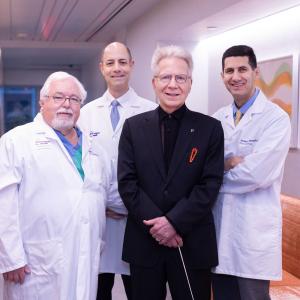
Cheryl Amistad, RN
PHOTO: Maryan Lim
A quick getaway with friends is a frequent and usually nondramatic event for Cheryl Amistad, RN, but on her recent flight back to New York from Seattle, the nurse, who has worked for NYU Langone Health for a decade, had to spring into action when a fellow passenger collapsed in the aisle next to her.
“I was startled awake by a heavy thump. It was about midway through the flight, so the cabin was dark, but as I came to a little more I saw that a woman was kneeling in the aisle next to my seat,” says Amistad, who works as a nurse at NYU Langone’s Ronald O. Perelman Center for Emergency Services in Manhattan. “She wasn’t getting back up or answering my questions. For a second it all felt completely surreal, but the fact that she wasn’t moving at all shifted something inside of me, and I just started following emergency protocol.”
From the opposite side of the aisle, another passenger, who was an emergency medical technician (EMT), also jumped out of his seat, and together they got the 49-year-old woman, named Melissa, onto her back in the narrow aisle. When she started responding to questions, she complained of dizziness and said she was unable to breathe. They removed her face mask, and thanks to the crew, who were swift to turn on the cabin lights and bring the emergency equipment, they were able to work quickly to give Melissa oxygen.
“I tried to get her blood pressure, but it was impossible to get an accurate reading. It was low, however, so we arranged some carry-on bags to elevate her legs, putting her in what’s called the Trendelenburg position, and we also had the defibrillator on hand, just in case,” Amistad says.
A Bumpy Descent
As Melissa became more coherent, she was able to answer questions about her medical history and what had led up to her initial collapse. But about 40 minutes before landing her condition worsened and she started passing out again.
“We were concerned about losing her pulse completely, so we monitored it closely and decided we had to give her IV fluids,” says Amistad, adding that inserting an intravenous (IV) line on an aircraft that’s preparing to land is no easy task. “We were descending, so the turbulence made it quite challenging. But I’ve been a nurse for 16 years—10 of them with NYU Langone—and fortunately the extensive training and frequent simulations we go through, along with my experience, ultimately allowed me to get it done.”
Debra Albert, DNP, MBA, RN, NEA-BC, chief nursing officer and senior vice president for patient care services, applauds Amistad’s handling of the situation, and she is not at all surprised that an NYU Langone nurse stepped up and took action as needed. “Our nurses are experts in what they do. That expertise and the call to assist others in need is no doubt what drove Cheryl to take action in this unusual circumstance,” she says. “This example shows who our nurses are and how they apply their professional skills and abilities in all they do for the betterment of our community and society at large. Cheryl’s actions speak to the high standard to which our nurses hold themselves, and I commend her for her quick thinking and level head, which ultimately resulted in a positive outcome for her patient and fellow passenger.”
A Safe Landing
After the plane landed safely at Newark Liberty International Airport, the fire department and emergency medical services (EMS), who were on standby thanks to the flight crew, took over the patient’s care, and Amistad could step aside. “I couldn’t fully believe what had just happened. In our field, we’re trained to act in an emergency, so it doesn’t really hit you until after it’s over,” she says, adding that in her mind the positive outcome was the result of a team effort. “The EMT and I worked seamlessly together, and the flight crew was amazing. They were constantly anticipating what we’d be needing, which just made our job that much easier,” she says.

